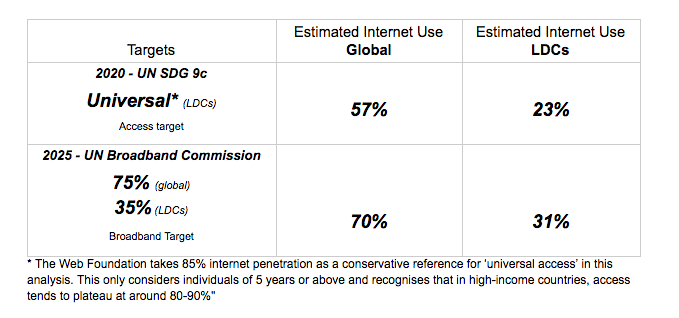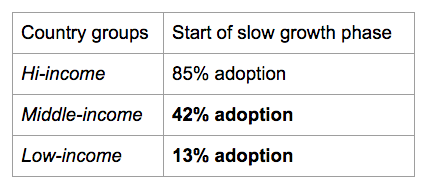By Carlos Iglesias, Web Foundation Senior Research Manager.
Imagine how much greater this challenge would be if this pandemic struck 15 years ago, before we had access to fast broadband, smart devices and a stack of online services ready to help us navigate life from our living rooms.
Imagine then, what it’s like for almost half of the global population who still have no internet access. They don’t have critical health advice at their fingertips. They can’t check in with friends and family by video call. Online working and learning from home is not an option.
Most of those offline live in low and middle-income countries. Women, the elderly and people in rural areas too are disproportionately without internet access. Compounding the connectivity gap, people in poorer countries are also less likely to have access to resources needed to protect themselves, like a safe place to isolate, a strong healthcare system and the financial safety-net to be able to forgo work if necessary.
Those most vulnerable to Covid-19 are without internet access at the moment it could benefit them most. And as coronavirus hits harder across Africa and other regions with a large number of low-income countries, the impact will become increasingly clear.
The Web Foundation and the Alliance for Affordable Internet (A4AI) have called for governments and companies to take steps to get people connected as quickly as possible. But these measures are only an urgent sticking plaster for a much bigger problem — the persistent digital divide. The Covid-19 crisis exposes glaring digital inequalities and underlines that the internet is not a luxury, but a lifeline.
Off target on universal internet access
Yet we are failing to meet global targets on increasing internet availability. There are two primary global connectivity targets, both from the United Nations:
The United Nations Sustainable Development Goals (SDGs), includes a target for universal and affordable access to the internet in least developed countries (LDCs) by 2020.
And the UN Broadband Commission has a series of targets for “Connecting the Other Half” — one being to reach broadband-internet user penetration of 75% worldwide and 35% in least developed countries by 2025.
Using historical data, we have built a forecasting model to estimate global and regional internet use. Based on this analysis, originally published in Communications of the ACM, it’s clear that we’re on our way to missing both these targets.
With only 54% of the world online today, we have already effectively failed to meet the SDG universal access target. Our model predicts we’ll get to just 57% this year — without urgent action we’ll miss it by decades. Our model also suggests we’ll miss the less ambitious Broadband Commission target by about 5% points.

Failing to deliver basic connectivity
These targets are not very ambitious in what they measure.
The SDG target uses the International Telecommunications Union (ITU) definition of internet users: those who have connected from any location and device in the last three months. That could mean occasionally checking emails on a public WiFi network with a shared family phone — not a level of connectivity with which most of us would be satisfied.
And the Broadband Commission target is for people to have a broadband connection. But because there is no global data on broadband delivery, our predictions are based on the less ambitious ITU definition of access. This means that in reality, the share of people with a broadband connection will really be far lower than we’ve projected.
In this crisis, when the internet has become essential infrastructure, people need regular access to a suitable device and enough data at sufficient speeds — what the Alliance for Affordable Internet (A4AI) calls ‘meaningful connectivity’. If this more ambitious metric was used to measure those online, far fewer people would be counted as connected.
That we’re falling short on these limited objectives underlines how much has to be done to tackle digital inequality.
Individuals (%) using the internet in high, middle, and low low-income countries (Solid lines: 1990-2016 reported ITU ICT indicators WTI database 2018 edition. Dashed lines: 2017-2025 Web Foundation projections (see Communications of the ACM paper).
Just as an acceleration of people coming online is needed to hit these targets, we’re seeing a global slowdown. Whereas a decade ago, people were coming online at the rate of about 15% per year globally, in the last few years the rate has dropped to around a third of that.
Our projections indicate that most regions have entered their plateau phase where the rate of new users stops accelerating. And worryingly, connectivity in low income countries has started to level at around 13% adoption, compared with 85% adoption in high-income countries. In countries where so much of the population is yet to be connected, we’d hope to see accelerating growth for some time.

This slowdown means we’ll keep missing targets set on global connectivity. But more importantly, it means generations will be denied internet connectivity in an increasingly digital world, setting new faultlines of inequality. It’s time to recognise that internet access is a public good and a basic right — and work urgently to make sure that next time we face a global crisis, everyone has the web as a lifeline to help them through it.
In the short term, this means governments and companies taking emergency steps like those outlined in our policy brief to help people access the internet right away. In the longer term, more work is needed to better understand the barriers to closing the digital gap and we need more investment in strategies to connect those with no or little internet access. Ultimately this demands a combination of innovative policies, regulation, technologies, and new business models — things that A4AI is working hard to achieve.
The Contract for the Web, launched by the Web Foundation last year, calls for both governments and companies to make affordable access a priority so that everyone can access the web’s benefits.
Getting internet access for everyone is one the most pressing digital challenges of our time — and an objective that we must not fail to meet.
For updates about our work, sign up to our newsletter and follow us on Twitter at @webfoundation.
To receive a weekly news brief on the most important stories in tech, subscribe to The Web This Week.
